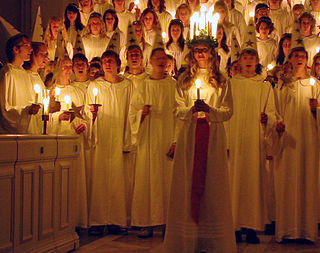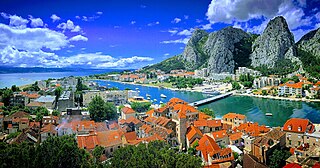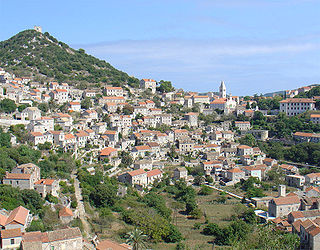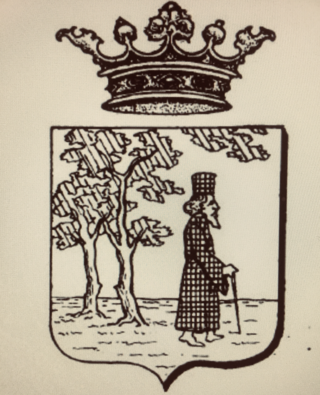Related Research Articles

Babylon the Great, commonly known as the Whore of Babylon, refers to both a symbolic female figure and a place of evil as mentioned in the Book of Revelation of the New Testament. Her full title is stated in Revelation 17:5 as "Mystery, Babylon the Great, the Mother of Harlots and Abominations of the Earth".

Lucia of Syracuse (283–304), also called Saint Lucia was a Roman Christian martyr who died during the Diocletianic Persecution. She is venerated as a saint in Catholic, Anglican, Lutheran, and Eastern Orthodox Christianity. She is one of eight women explicitly commemorated by Catholics in the Canon of the Mass. Her traditional feast day, known in Europe as Saint Lucy's Day, is observed by Western Christians on 13 December. Lucia of Syracuse was honored in the Middle Ages and remained a well-known saint in early modern England. She is one of the best known virgin martyrs, along with Agatha of Sicily, Agnes of Rome, Cecilia of Rome, and Catherine of Alexandria.

Marija Petković, also known as "The Blessed Mary of Jesus Crucified Petković";, was the founder of the Catholic Congregation of the Daughters of Mercy. She was recognized by the Roman Catholic Church as a Venerable Servant of God on 8 May 1998, and was beatified by Pope John Paul II on 6 June 2003.

Korčula is a Croatian island in the Adriatic Sea. It has an area of 279 km2 (108 sq mi), is 46.8 km (29.1 mi) long and on average 7.8 km (4.8 mi) wide, and lies just off the Dalmatian coast. Its 15,522 inhabitants (2011) make it the second most populous Adriatic island after Krk. The population are almost entirely ethnic Croats (95.74%). The island is twinned with Rothesay in Scotland. It is known for Grk, a white wine that is only produced here and not exported due to limited production.

Saint Lucy's Day, also called the Feast of Saint Lucy, is a Christian feast day observed on 13 December. The observance commemorates Lucia of Syracuse, an early-fourth-century virgin martyr under the Diocletianic Persecution. According to legend, she brought food and aid to Christians hiding in the Roman catacombs, wearing a candle-lit wreath on her head to light her way, leaving both hands free to carry as much food as possible. Because her name means "light" and her feast day had at one time coincided with the shortest day of the year prior to calendar reforms, it is now widely celebrated as a festival of light. Falling within the Advent season, Saint Lucy's Day is viewed as a precursor of Christmastide, pointing to the arrival of the Light of Christ in the calendar on 25 December, Christmas Day.

Saint Anastasia is a Christian saint and martyr who died at Sirmium in the Roman province of Pannonia Secunda. In the Eastern Orthodox Church, she is venerated as St. Anastasia the Pharmakolytria, i.e. "Deliverer from Potions". This epithet is also translated as "One who Cures (Wounds)" in Lampe's A Patristic Greek Lexicon.

Omiš is a town and port in the Dalmatia region of Croatia, and a municipality in the Split-Dalmatia County. The town is approximately 25 kilometres south-east of Croatia's second largest city, Split, where the Cetina River meets the Adriatic Sea. Omiš municipality has a population of 14,936 and its area is 266 square kilometres (103 sq mi).

Lastovo is an island municipality in the Dubrovnik-Neretva County in Croatia. The municipality consists of 46 islands with a total population of 792 people, of which 94,7% are ethnic Croats, and a land area of approximately 53 square kilometres (20 sq mi). The biggest island in the municipality is also named Lastovo, as is the largest town. The majority of the population lives on the 46 square kilometres (18 sq mi) island of Lastovo.

Blato is a municipality on the island of Korčula in Croatia. It can be reached by the main island road from town of Korčula. The road runs through the forests in the middle of the island of Korčula.

Lumbarda is a village and a municipality located on the eastern tip of Korčula in Croatia, seven kilometers away from the town of Korčula. A road passing through a picturesque area of pine woods and olive groves connects these two places. Lumbarda is surrounded by sandy vineyards and sandy beaches such as Vela Pržina, Bilin Žal and Tatinja. Lumbarda is a tourist centre, many of its 1,200 inhabitants are active in the local tourist service but they are also wine-growers, fishermen and stone-dressers. Lumbarda has a rich history preserved in written documents dating back to more than 2,000 years ago.

Smokvica is a village on the island of Korčula and a municipality in the Dubrovnik-Neretva County in Croatia. Smokvica is located in the centre of the island of Korčula, about 4 kilometers west of Čara, 13 kilometers east of Blato and 4 kilometers north from Brna. It is known as the birthplace of one of the best-known Croatian wines - Pošip.

Vela Luka is a small town and a municipality in Dubrovnik-Neretva County in southern Dalmatia, Croatia. The town is located on the western side of the island of Korčula at the bottom of a wide bay which has many indented coves. Vela Luka developed at the beginning of the 19th century in a deep sheltered bay. Its name means "big harbour" in Croatian chakavian. Inhabitants of the Island of Korčula and Pelješac often refer to it simply as "Luka". It has several hotels and a medical centre called Kalos. The inhabitants are farmers, fishermen and workers in tourism. The town also has small industrial plants.

Korčula is a town on the east coast of the island of Korčula, in Croatia, in the Adriatic.

Christina of Bolsena, also known as Christine of Bolsena, or in the Eastern Orthodox Church as Christina the Great martyr, is venerated as a virgin martyr of the third century. Archaeological excavations of an underground cemetery constructed over her tomb have shown that she was venerated at Bolsena by the fourth century.

Antonietta Brandeis (1848–1926), was a Czech-born Italian landscape, genre and portrait painter, as well as a painter of religious subjects for altarpieces.
Potirna is a village on the island of Korčula in Croatia. Korčula is part of the Dalmatian coast and it belongs to the Dubrovnik-Neretva County. Potirna is part of the Municipality of Blato.

Čara is a village on the island of Korčula in Croatia. Korčula the island, is part of the Dalmatian coast and it belongs to the Dubrovnik-Neretva county.

Moreška is a traditional sword dance from the town of Korčula, on the Croatian island of the same name in the Adriatic. Dating back hundreds of years, the Moreška is an elaborate production involving two groups of dancers, engaging in a mock battle over the fate of a veiled young woman. Originally performed rarely on special occasions, in modern times the Moreška is performed weekly for visiting tourists. The two sides of battling dancers were originally Moors and Christians, recalling the Spanish battles of the Reconquista in the Middle Ages. However, at some point in the 19th century in Korčula, the sides changed from Christians vs. Moors, to Croats vs. Moors, or simply "White" and "Black", with the non-Moor side emerging victorious.

A bracera or brazzera is a traditional Adriatic coastal cargo sailing vessel originated in Dalmatia and first recorded in the 16th-century chronicles. Along with its larger sisters - trabakuls and peligs, braceras formed the backbone of the commercial fleet on the Adriatic Sea with one masted one being the most prominent and best known. This solid and very mobile boat with wide hips and blunt bow was particularly suitable for commerce and communication between the many islands of the Adriatic as well as neighboring coasts. Already in the 19th century over 800 of them were listed in the Austro-Hungarian fleet register covering vessels of the Dalmatian and Istrian coasts. Adriatic braceras distinguish from the vessels carrying same/similar names like, for example, in the Aegean Sea. Unlike there, on the Adriatic the term refers to the entire boat, the system that consists of the hull and the rig as well, and not merely the sail.

The Calogerà family, also recorded as Kalogeras or Kaloghera, were a Byzantine, and later Greco-Venetian noble family that produced many important individuals in the history of Europe and Brazil. With origins in Cyprus and Byzantium, the family achieved levels of wealth, prominence, and aristocracy over the centuries in branches found across modern Greece, Italy, Croatia, Serbia, Albania, Romania, France, and Brazil. The Calogerà are studied in numerous registers of nobility, including the Libro d'Oro of Corfu, Wappenbuch des Königreichs Dalmatien (1873), Livre d'Or de la Noblesse Ionienne (1925), and Heraldika Shqiptare (2000), among others. Members and descendants of this family continue to serve important roles in their respective countries to this day.
References
- ↑ Holy Vincenc - Zaštitnica Blata Retrieved 6 January 2010
- ↑ Blato-Culturenet.hr Retrieved 6 January 2010
- ↑ UDC 929 (J. Kosirić Teodošević) Original scientific paper by K.Teodosevic Retrieved 6 January 2010.
- ↑ Blato-Korculainfo Archived 2009-08-21 at the Wayback Machine Retrieved 6 January 2010.
- ↑ Korcula-Historical Survey Retrieved 6 January 2010.
- ↑ Blato-Prizba Apartments Archived 2015-02-17 at the Wayback Machine Retrieved 6 January 2010.